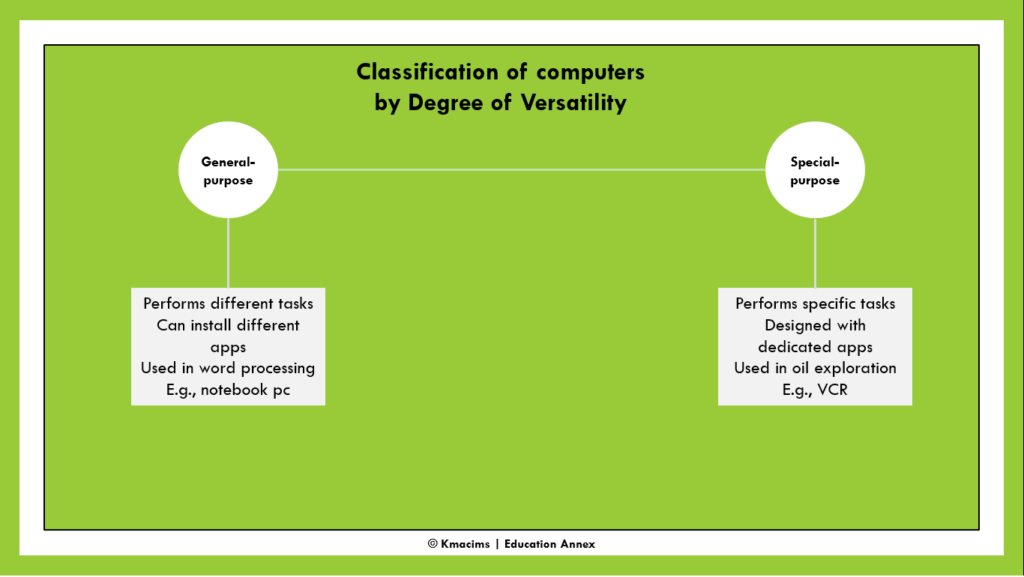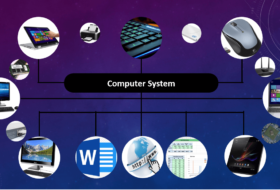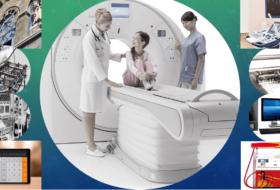Classification of computers by degree of versatility is a grouping of computer systems based on what they can do. It tries to define computer systems based on the tasks they are designed to perform.
Classification by degree of versatility is also called classification of computers by purpose. It addresses the following question:
What do we use a given computer for? What is the purpose for which a given computer is designed? Computers can be classified based on what they can do, otherwise called the degree of versatility.
Classification of Computers by Degree of Versatility
Therefore, classification of computers by degree of versatility looks at a computer based on the accomplishment of tasks.

The classification of computers by degree of versatility is in the following:
- General-purpose computers, and
- Special-purpose computers
General-Purpose Computers:
A general-purpose computer is a computer that is installed with different applications to carry out different tasks. The general purpose is used to define what is suitable for all purposes.
| Feature | Description |
| Task | Can perform different tasks |
| Application | Can install different kinds of applications. Allow users to install applications |
| Memory | Consumes a large amount of memory |
| Growth | Predicated by Moore’s law |
| Uses | Word processing, graphics designing, internet services |
| Examples | Desktop, laptop, smartphone |
General-purpose computers are defined by the computer’s architecture which allows different programs to be installed in them. The computer may be manufactured with preinstalled programs and also allows end-users the privilege to install other programs.
The rise in general-purpose computers was fueled by Moore’s Law. Moore’s law states that the number of transistors in a microprocessor (dense integrated circuit (IC)) will double every two years. For the past five (5) decades the law has been widely used in the semiconductor industry. The law serves a great deal in setting targets for research and development and long-term planning.
This exponential growth in microchips made computers smaller, faster, more efficient, and able to carry out tasks using different applications. As a result, computers that can carry out different tasks with dedicated programs become increasingly available.
In as much as they are called general-purpose computers, their ability to carry out tasks depends on available applications. Also, to install a given application, the computer must meet the minimum requirement to run such an application.
This means that you cannot create graphics with your general-purpose computer if you did not install a graphic package. Also, to install a graphic package, your computer must be configured to run such an application.
A general-purpose computer consists of hardware and software, and can be used to perform the following tasks:
- Create different kinds of designs including web, graphic, and CAD (computer-aided designs)
- Process word documents, spreadsheets, presentations, etc
- Access the internet, play games, and access emails
- Create and play videos, music, etc.
Examples of general-purpose computers include personal computers (desktops, laptops, etc), tablets, smartphones, etc.
Special-Purpose Computers:
Special purpose computers are designed to solve specialized problems. They are sometimes called dedicated computers because they are dedicated to handling specific tasks on a recurring basis.
| Feature | Description |
| Task | Can perform specified kind of task |
| Application | Designed with applications to enable it to perform a dedicated task |
| Memory | Consumes less amount of memory |
| Growth | Predicated by failing Moore’s law |
| Uses | Home appliance controllers, oil exploration, traffic control system |
| Examples | VCR, Microwave oven, classical molecular dynamic machines |
For example, the Jacquard loom was designed to produce complex designs on textiles. This is what it does on a repeated basis. They, therefore, perform the same tasks over their lifetime.
Unlike general-purpose computers which allow users the privilege to install applications, special-purpose computers come prepared to perform dedicated tasks. They are designed with the instructions to perform such specialized tasks built within them.
They are therefore more efficient, and can effectively carry out their functions. Also, they use less amount of memory since they accept a particular set of data, and they are very fast.
The industry is gradually driving away from general-purpose computers to special-purpose computers because Moore’s law is failing. Also, the drive towards special-purpose computers is enhanced by applications like deep learning and cryptocurrency mining. If Moore’s law finally fails, there is a tendency to revert to the origin, when specialized supercomputers were built.
There are three (3) classes of special-purpose systems, namely;
- Time embedded systems – these are devices with application-specific integrated circuits (ASCI). They can perform their tasks without an operating system.
- Multimedia systems – these are devices that incorporate multimedia data such as audio files, video conferencing, etc.
- Handheld systems – these are portable devices with special-purpose embedded operating systems.
Special-purpose computers are used in applications such as:
- Home appliance controllers and fuel injection in vehicles
- Oil exploration and weather forecasting simulations
- Traffic control and aircraft navigational systems
- Playing intensive video games and satellite tracking
- Defense and surveillance equipment, etc.
Some examples of special-purpose computers include VCR, microwave ovens, PDA, Navier-Stokes hydrodynamic solvers, classical molecular dynamic machines, Ising model computers, etc.
For more information:
Conclusion
A computer can be designed to solve a specific problem or different kinds of problems. Computers that solve different kinds of problems are known as general-purpose computers. While computers that are designed to solve specialized problems are called special-purpose computers.




